The Signal Characteristics of Oil and Gas Pipeline Leakage Detection Based on Magneto-Mechanical Effects
Abstract
1. Introduction
2. Model Development
2.1. Classical Model
2.2. An Improved Magnetic Dipole Model
3. Calculation and Analysis
3.1. Relationship between Internal Pressure and Stress
3.2. Effects of Stress on Magnetic Charge Density
3.3. The Effects of Elastic Strain on the MFL Signals
3.4. The Influences of Plastic Deformation on MFL Signals
3.5. Comparative Analysis of Improved Magnetic Charge Model and Classical Magnetic Charge Model with Different Defect Sizes
3.5.1. Comparative Analysis of Improved Magnetic Charge Model and Classical
Magnetic Charge Model under Different Defect Lengths
3.5.2. Comparative Analysis between the Improved Magnetic Charge Model and the Classical Magnetic Charge under Different Defect Depths
4. Experiment and Analysis
4.1. Experimental Equipment and Materials
4.2. Experimental Analysis and Verification of Elastic Deformation
4.3. Experimental Analysis and Verification of Plastic Deformation
5. Conclusions
- (1)
- The characteristic values of the MFL signals under elastic stress gradually decreased with the increase in the stress, and the characteristic values of axial and radial components conformed to the nonlinear decline.
- (2)
- At the plastic stage, the characteristic values of the MFL signals initially increased, and then decreased, with the rise of the deformation, showing an inflection point. This may be attributed to the material properties. The radial component of the MFL signals exhibited sensitivity to the change in the plastic deformation.
- (3)
- The MFL signals in the elastic and plastic stages were compared with the uniform magnetic charge model. The accuracy of the axial component of the MFL signals in the elastic stage rose by 16%, and the accuracy of the radial component of the MFL signals was elevated by 17%. The accuracy of the axial component of the MFL signals and the radial component of the MFL signals increased by 9.15% and 9%, respectively, in the plastic stage. It can effectively predict the magnitude of MFL signals under stress.
Author Contributions
Funding
Institutional Review Board Statement
Informed Consent Statement
Data Availability Statement
Conflicts of Interest
References
- Chen, Y.; Zhang, L.; Hu, J.; Liu, Z.; Xu, K. Emergency response recommendation for long-distance oil and gas pipeline based on an accident case representation model. J. Loss Prev. Process Ind. 2022, 77, 104779. [Google Scholar] [CrossRef]
- Li, M.; Lin, S.; Xu, J.; Jia, S. Implementation of PetroChina Pipeline Company on Pipeline Integrity Management to Improve the Safety and Efficient Operation of Long-distance Pipeline. In Proceedings of the 8th International Symposium on Project Management, Bejing, China, 4–5 July 2020; pp. 573–585. [Google Scholar] [CrossRef]
- Zhou, M.; Huang, X.; Chen, Q.; Yan, Y.; Li, J.; Zhang, Y. Research on steel stress measurement based on weak AC magnetization. J. Electron. Meas. Instrum. 2021, 35, 23–31. [Google Scholar] [CrossRef]
- Ong, Z.C.; Eng, H.C.; Noroozi, S. Non-destructive testing and assessment of a piping system with excessive vibration and recurrence crack issue: An industrial case study. Eng. Fail. Anal. 2016, 82, 280–297. [Google Scholar] [CrossRef]
- Yang, L.; Geng, H.; Gao, S. Magnetic flux leakage internal detection technology of the long distance oil pipeline. Chin. J. Sci. Instrum. 2016, 37, 1736–1746. [Google Scholar] [CrossRef]
- Zhang, D.; Huang, W.; Zhang, J.; Jin, W.; Dong, Y. Prediction of fatigue damage in ribbed steel bars under cyclic loading with a magneto-mechanical coupling model. J. Magn. Magn. Mater. 2021, 530, 167943. [Google Scholar] [CrossRef]
- Xu, L.; Liu, F.; Ding, Y.; Li, Z.; Xie, Y. Residual thickness detection of pipeline base on electromagnetic uitrasonic shear wave. J. Beijing Univ. Aeronaut. Astronaut. 2022, 48, 1767–1773. [Google Scholar] [CrossRef]
- Peng, L.; Huang, S.; Wang, S.; Zhao, W. A Simplified Lift-Off Correction for Three Components of the Magnetic Flux Leakage Signal for Defect Detection. IEEE Trans. Instrum. Meas. 2021, 70, 1–9. [Google Scholar] [CrossRef]
- Long, Y.; Huang, S.; Peng, L.; Wang, S.; Zhao, W. A Characteristic Approximation Approach to Defect Opening Profile Recognition in Magnetic Flux Leakage Detection. IEEE Trans. Instrum. Meas. 2021, 70, 6003912. [Google Scholar] [CrossRef]
- Hu, J.; Jiao, X.; Zheng, L.; Gang, B.; Liu, S. An improved support vector regression method for quantifying magnetic leakage defects in three-axis pipeline. Nondestruct. Test. 2021, 43, 62–68. [Google Scholar]
- Clausse, B.; Lhémery, A.; Walaszek, H. A model to predict the ultrasonic field radiated by magnetostrictive effects induced by EMAT in ferromagnetic parts. J. Phys. Conf. Ser. 2017, 797, 012004. [Google Scholar] [CrossRef]
- Wei, M.; Tu, F.; Zhang, P.; Jiang, L.; Jiang, P.; Jing, Y. Composite excitation multi-extension direction defect magnetic flux leakage detection technology. J. Meas. Sci. Instrum. 2022, 13, 156–165. [Google Scholar]
- Geng, H.; Xia, H.; Wang, G. Study on defect location method of inner and outer wall of pipeline during high-speed magnetic flux leakage testing. Chin. J. Sci. Instrum. 2022, 43, 70–78. [Google Scholar] [CrossRef]
- Lang, X.; Li, P.; Hu, Z.; Ren, H.; Li, Y. Leak Detection and Location of Pipelines Based on LMD and Least Squares Twin Support Vector Machine. IEEE Access 2017, 5, 8659–8668. [Google Scholar] [CrossRef]
- Zhu, H.; Liu, H.; Li, H.; Huang, S.; Su, Z. Quantitative Analysis Method for Pipeline Defects Based on Optimized RBF Neural Network. Instrum. Tech. Sens. 2016, 83–86. [Google Scholar] [CrossRef]
- Xu, P.; Fang, Z.; Wang, P.; Geng, M.; Xu, Y. Quantitative Evaluation Method of Defects Based on Transient Characteristics of PMFL. China Mech. Eng. 2021, 32, 860–866, 881. [Google Scholar]
- Liu, B.; Luo, N.; Feng, G. Quantitative Study on MFL Signal of Pipeline Composite Defect Based on Improved Magnetic Charge Model. Sensors 2021, 21, 3412. [Google Scholar] [CrossRef]
- Wang, Y.; Melikhov, Y.; Meydan, T.; Yang, Z.; Wu, D.; Wu, B.; He, C.; Liu, X. Stress-Dependent Magnetic Flux Leakage: Finite Element Modelling Simulations Versus Experiments. J. Nondestruct. Eval. 2020, 39, 1–9. [Google Scholar] [CrossRef]
- Yang, L.; Zheng, F.; Gao, S.; Huang, P.; Bai, S. An anaiytical model of electormagnetic stress detection for pipeline based on magneto-mechanical coupling model. Chin. J. Sci. Instrum. 2021, 41, 249–258. [Google Scholar] [CrossRef]
- Liu, B.; Cao, Y.; Wang, D.; He, L.; Yang, L. Quantitative analsis of the magnetic memory yielding singal characteristics based on the LMTO algorithm. Chin. J. Sci. Instrum. 2017, 38, 1413–1420. [Google Scholar] [CrossRef]
- Dutta, S.M.; Ghorbel, F.H.; Stanley, R.K. Dipole Modeling of Magnetic Flux Leakage. IEEE Trans. Magn. 2009, 45, 1959–1965. [Google Scholar] [CrossRef]
- Wu, D.; Liu, Z.; Wang, X.; Su, L. Mechanism analysis of influence of surface-breaking orientation on magnetic leakage field distribution. Acta Phys. Sin. 2017, 66, 293–304. [Google Scholar]
- Hosseingholizadeh, S.; Filleter, T.; Sinclair, A.N. Evaluation of a Magnetic Dipole Model in a DC Magnetic Flux Leakage System. IEEE Trans. Magn. 2019, 55, 6200407. [Google Scholar] [CrossRef]
- Liu, T.; Liu, B.; Feng, G.; Lian, Z.; Yang, L. Quantization of pipeline magnetic flux leakage detection signal under load. Chin. J. Sci. Instrum. 2022, 43, 262–273. [Google Scholar] [CrossRef]
- Huang, X.; Wu, J.; Sun, Y.; Kang, Y. 3D magnetic dipole models of magnetic flux leakage for ‘concave’ and ‘bump’ defects. Int. J. Appl. Electromagn. Mech. 2018, 59, 1305–1312. [Google Scholar] [CrossRef]
- Huang, R.; Li, H.; Jiang, M.; Wang, Y.; Zhao, C.; Qiu, J.; Xiong, K.; Ji, H. Magnetic charge model of defect in magnetic flux leakage testing. Int. J. Appl. Electromagn. Mech. 2020, 64, 1315–1323. [Google Scholar] [CrossRef]
- Xu, Z.S.; Xu, Y.; Wang, J.B. Quantitative Detection Principle and Application of Crack in MFL Method; National Defend Industry Press: Beijing, China, 2005; Volume 1, p. 124. (in Chinese) [Google Scholar]
- Zhong, W. The Watersheds of Magnetic Forces and Magneitc Charges on the End Surfaces of a Rectangular Steel Component Magnetized Longitudinally. Nondestruct. Test. 2005, 349–351, +363. Available online: https://kns.cnki.net/kcms2/article/abstract?v=3uoqIhG8C44YLTlOAiTRKgchrJ08w1e7F1IFNsBV5UuooOozlxTTWC9DEgN391DFYL7aUUMM4a0FhFFJ_TLq80NuvpjIN1Ck&uniplatform=NZKPT (accessed on 1 February 2023).
- Zhong, W. The Repulsive Interaction Between Uniformly Distributed aREAL mAGENTIC Charges in a Round Olane. Nondestruct. Test. 2010, 32, 160–162. [Google Scholar]
- Zhong, W. On the Proportional Coefficient α of Areal Density of Magnetic Charges σs toLinear Density of Magnetic Charges σl. Nondestruct. Test. 2009, 31, 2. [Google Scholar]
- Zhong, W. Distribution of Magnetic Charges in Arbitrarily-shaped Region on the Plane. Nondestruct. Test. 2008, 23–25. [Google Scholar]
- Liu, M.; Xu, Z.; Wang, J. Inverse Imaging for Defects Based on Energy Level of the Magnetic Dipole. China Mech. Eng. 2005, 16, 959. [Google Scholar] [CrossRef]
- Shi, P.; Bai, P.; Chen, H.; Su, S.; Chen, Z. The magneto-elastoplastic coupling effect on the magnetic flux leakage signal. J. Magn. Magn. Mater. 2020, 504, 166669. [Google Scholar] [CrossRef]
- Bratov, V.; Borodin, E. Comparison of dislocation density based approaches for prediction of defect structure evolution in aluminium and copper processed by ECAP. Mater. Sci. Eng. A 2015, 631, 10–17. [Google Scholar] [CrossRef]
- Shi, P.; Zhang, P.; Jin, K.; Chen, Z.; Zheng, X. Thermo-magneto-elastoplastic coupling model of metal magnetic memory testing method for ferromagnetic materials. J. Appl. Phys. 2018, 123, 145102. [Google Scholar] [CrossRef]
- Liu, B.; Ma, Z.; Liu, Z.; Luo, N.; Xu, X. Research on internal detection technology for axial crack of long-distance oil and gas pipeline based on micromagnetic method. Struct. Health Monit. 2020, 19, 1123–1136. [Google Scholar] [CrossRef]
- Shi, P.; Jin, K.; Zheng, X. A general nonlinear magnetomechanical model for ferromagnetic materials under a constant weak magnetic field. J. Appl. Phys. 2016, 119, 145103. [Google Scholar] [CrossRef]
- Liu, B.; Ma, Z.; He, L.; Wang, D.; Zhang, H.; Ren, J. Quantitative study on the propagation characteristics of MMM signal for stress internal detection of long distance oil and gas pipeline. NDT E Int. 2018, 100, 40–47. [Google Scholar] [CrossRef]
- Shi, P.; Zheng, X. Magnetic charge model for 3D MMM signals. Nondestruct. Test. Eval. 2016, 31, 45–60. [Google Scholar]
- Li, Q.; Zhao, M.; Ren, X.; Wang, L.; Feng, X.; Niu, Y. Construction Status and Development Trend of Chinese Oil & Gas Pipeline. Oil-Gas Field Surf. Eng. 2019, 38, 14–17. [Google Scholar]
- Zahoor, A. Closed Form Expressions for Fracture Mechanics Analysis of Cracked Pipes. J. Press. Vessel. Technol. 1985, 107, 203–205. [Google Scholar] [CrossRef]
- Liu, B.; Liu, Z.; Luo, N.; He, L.; Ren, J.; Zhang, H. Research on Features of Pipeline Crack Signal Based on Weak Magnetic Method. Sensors 2020, 20, 810. [Google Scholar] [CrossRef]
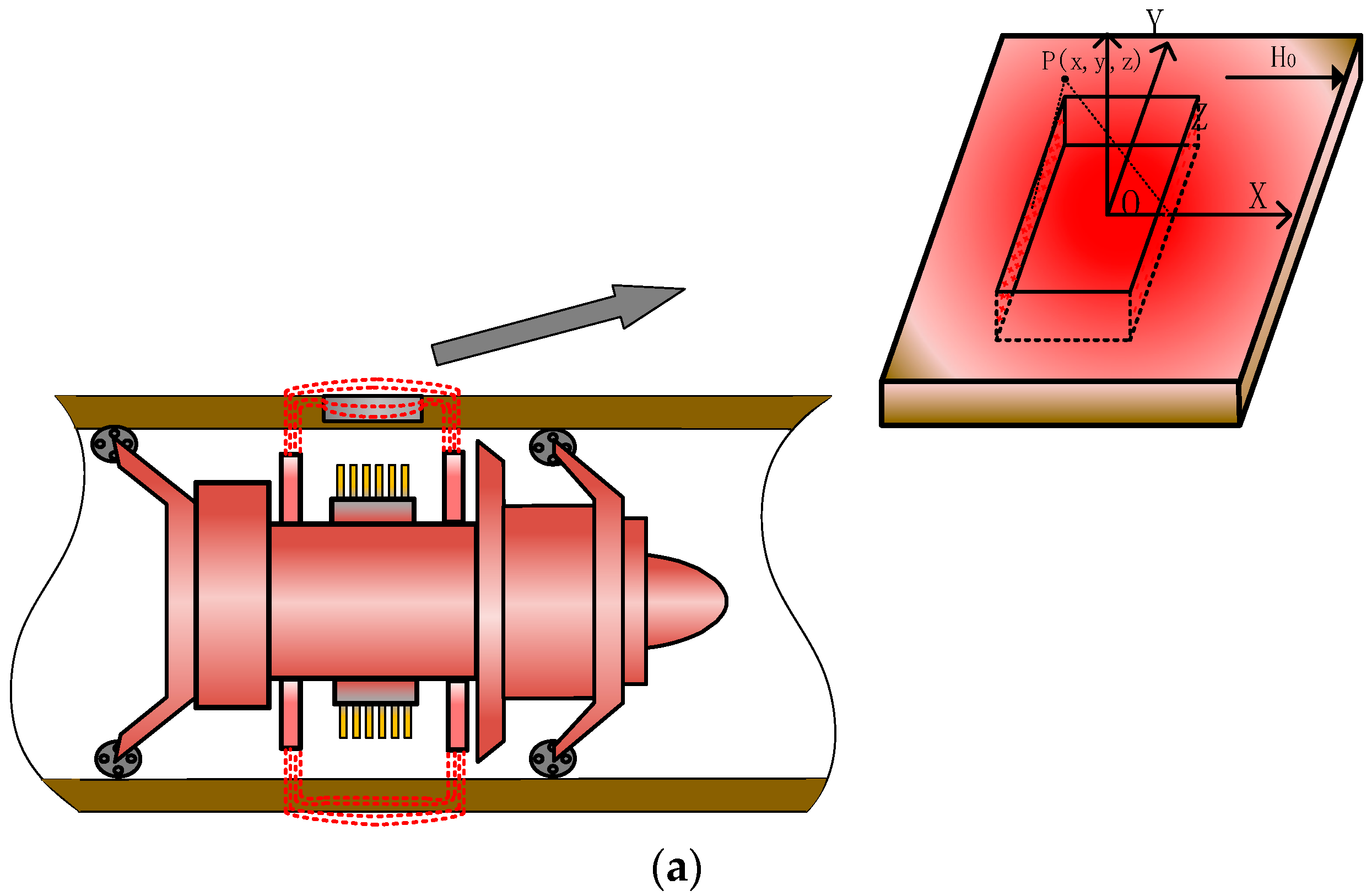
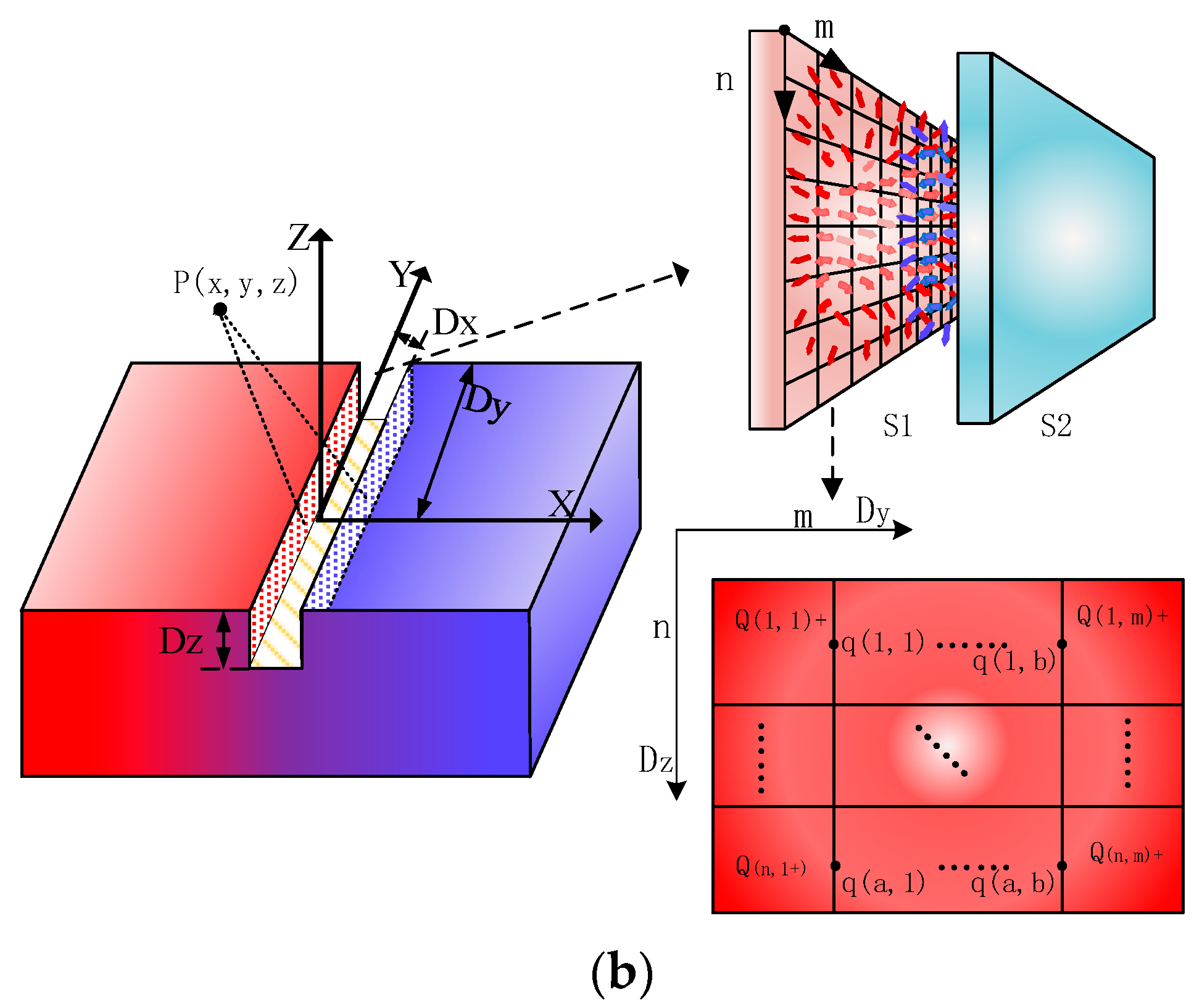

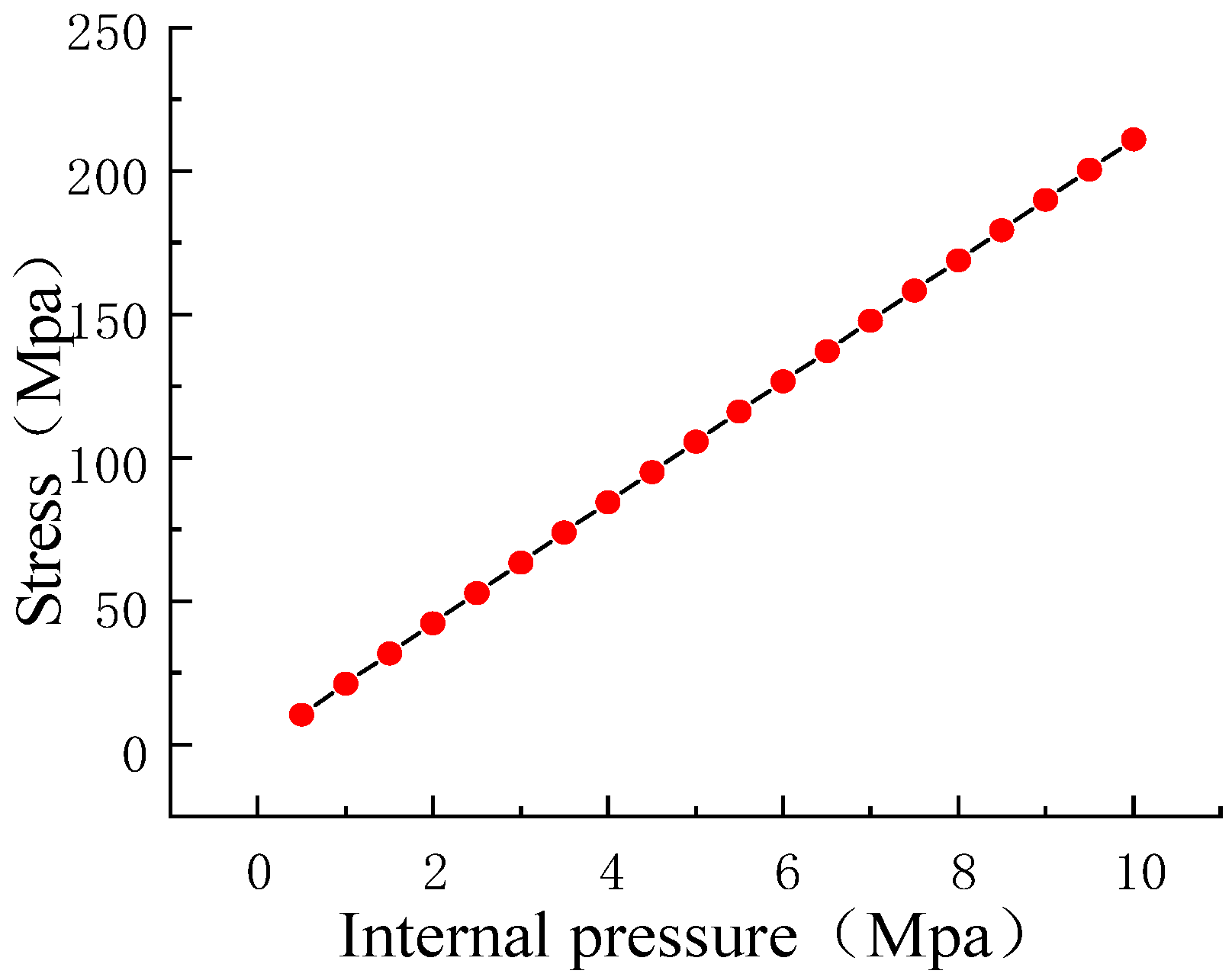
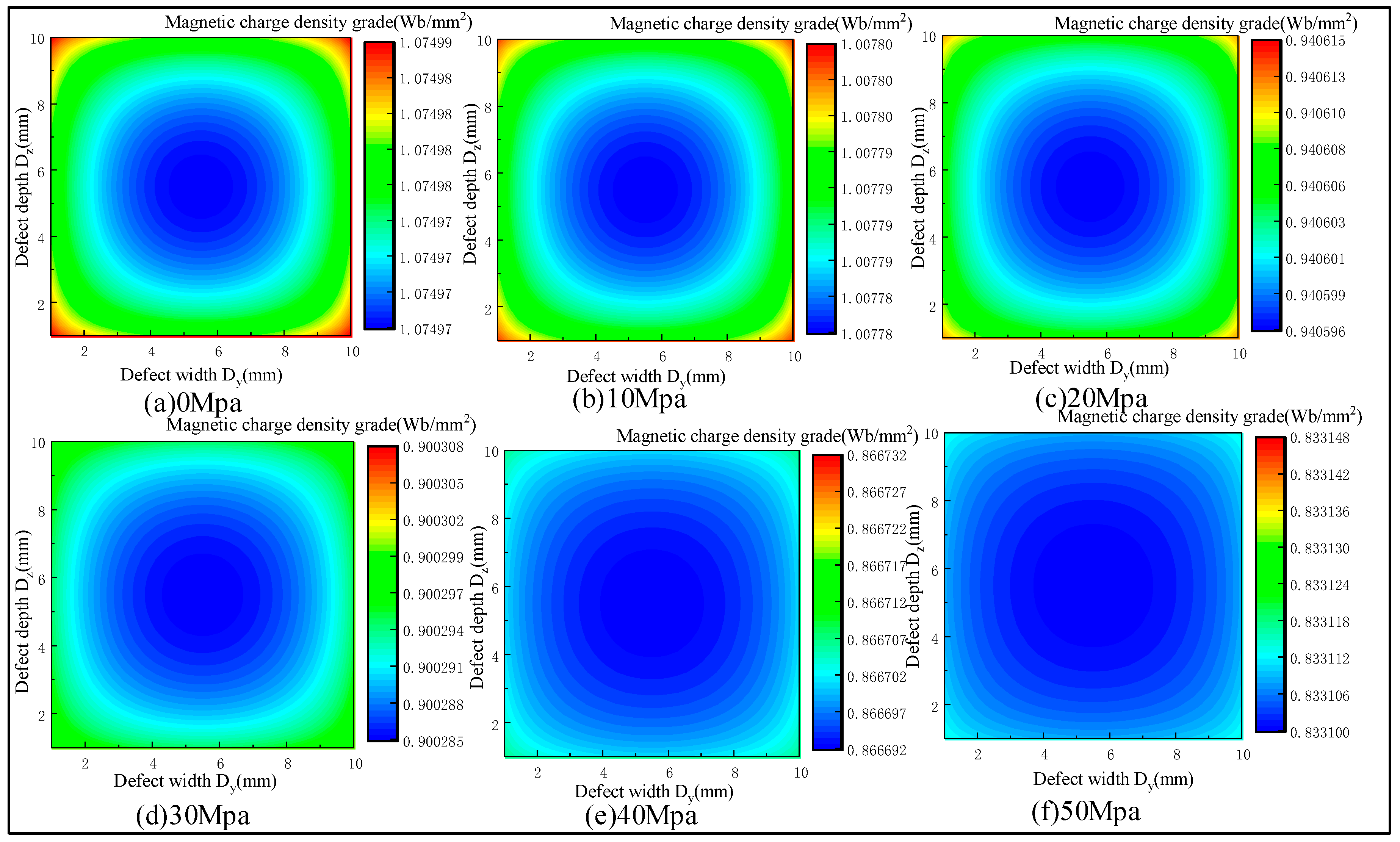

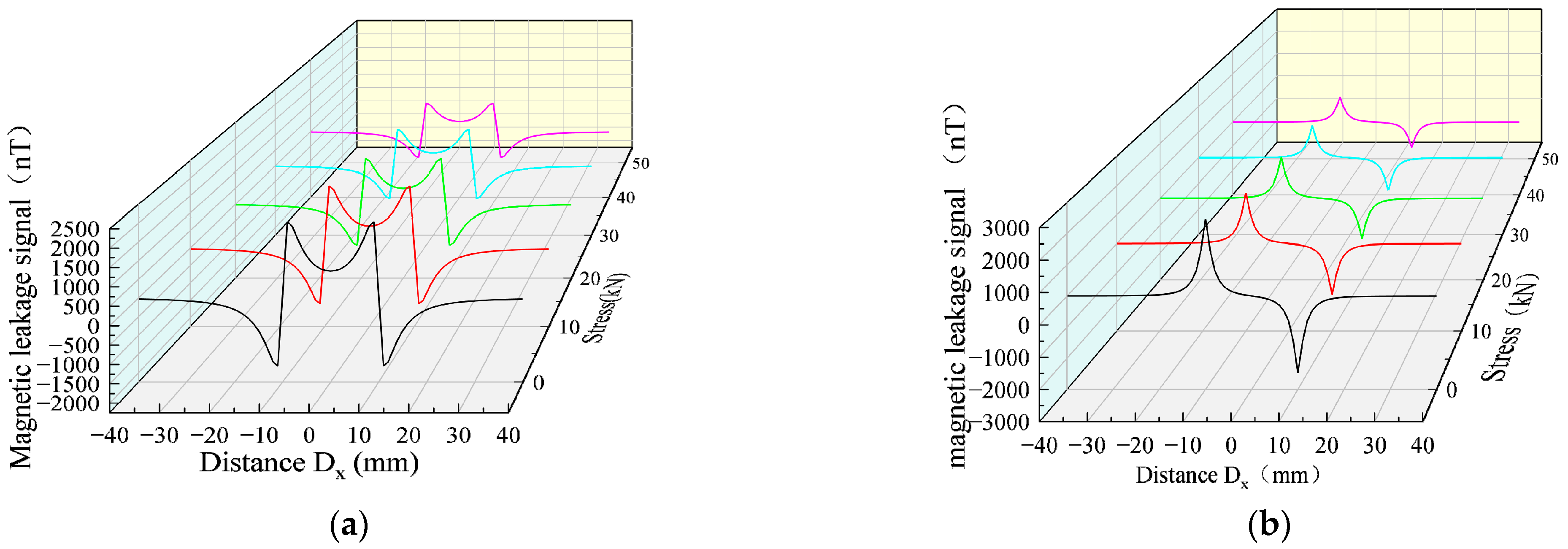
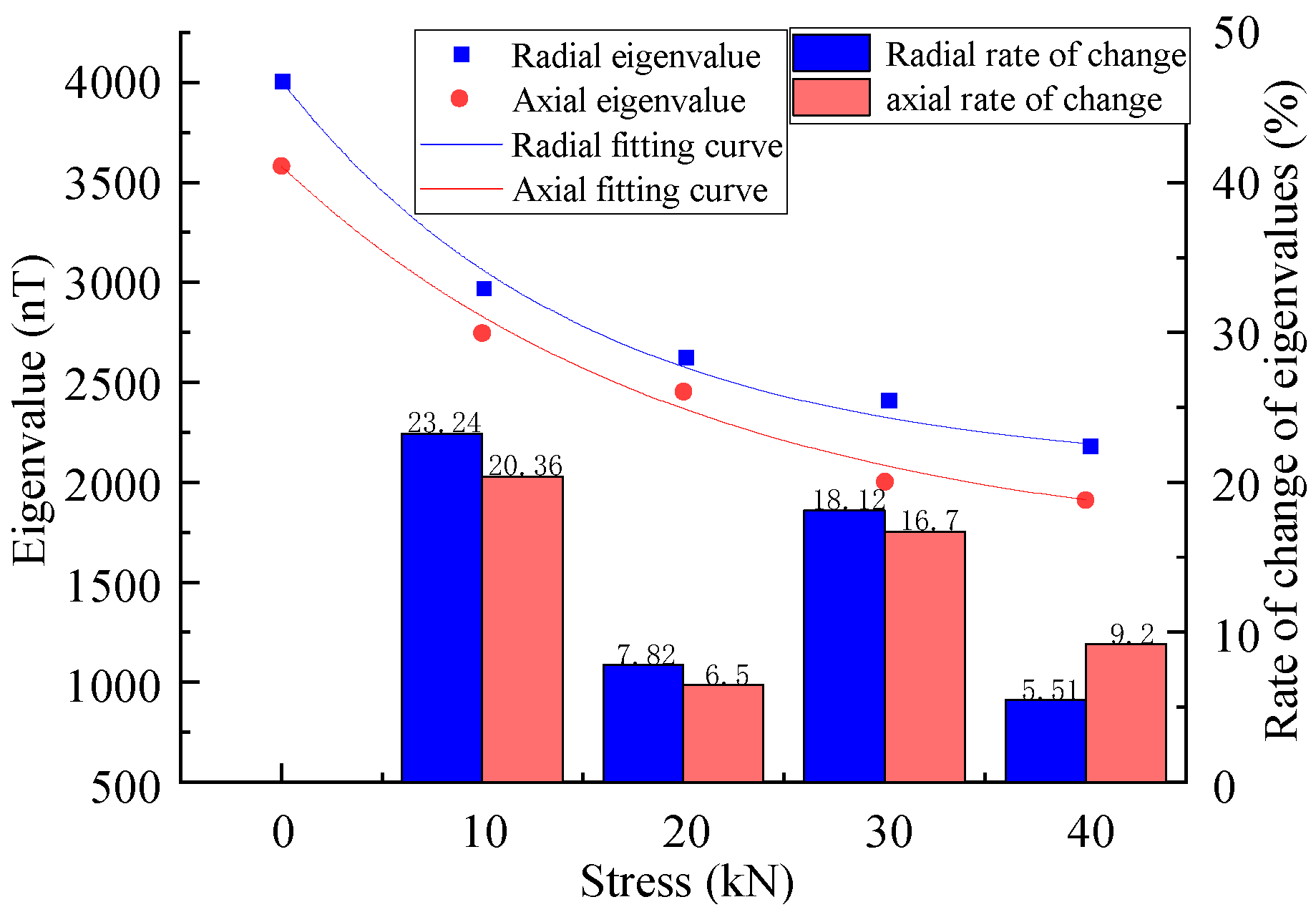

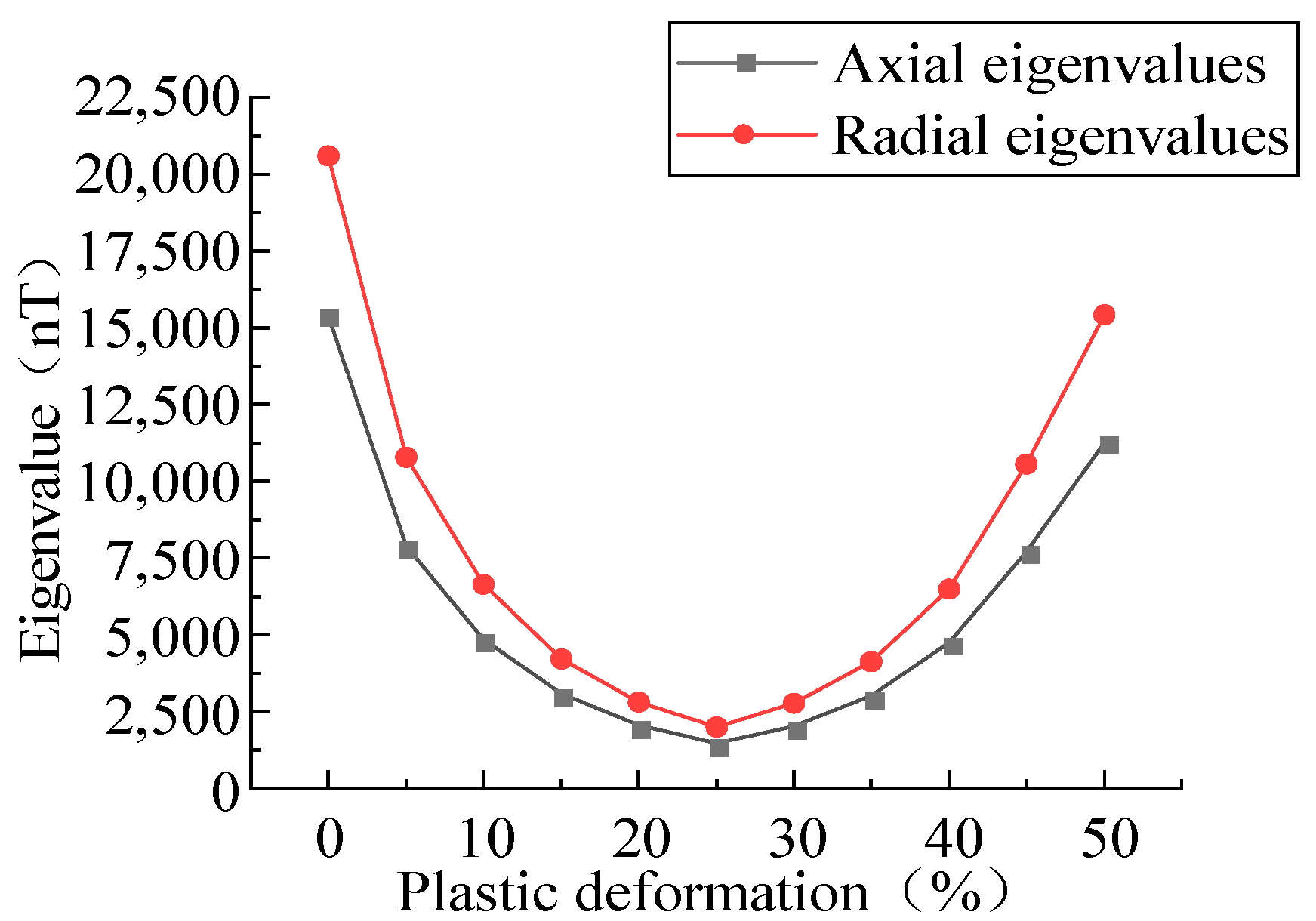

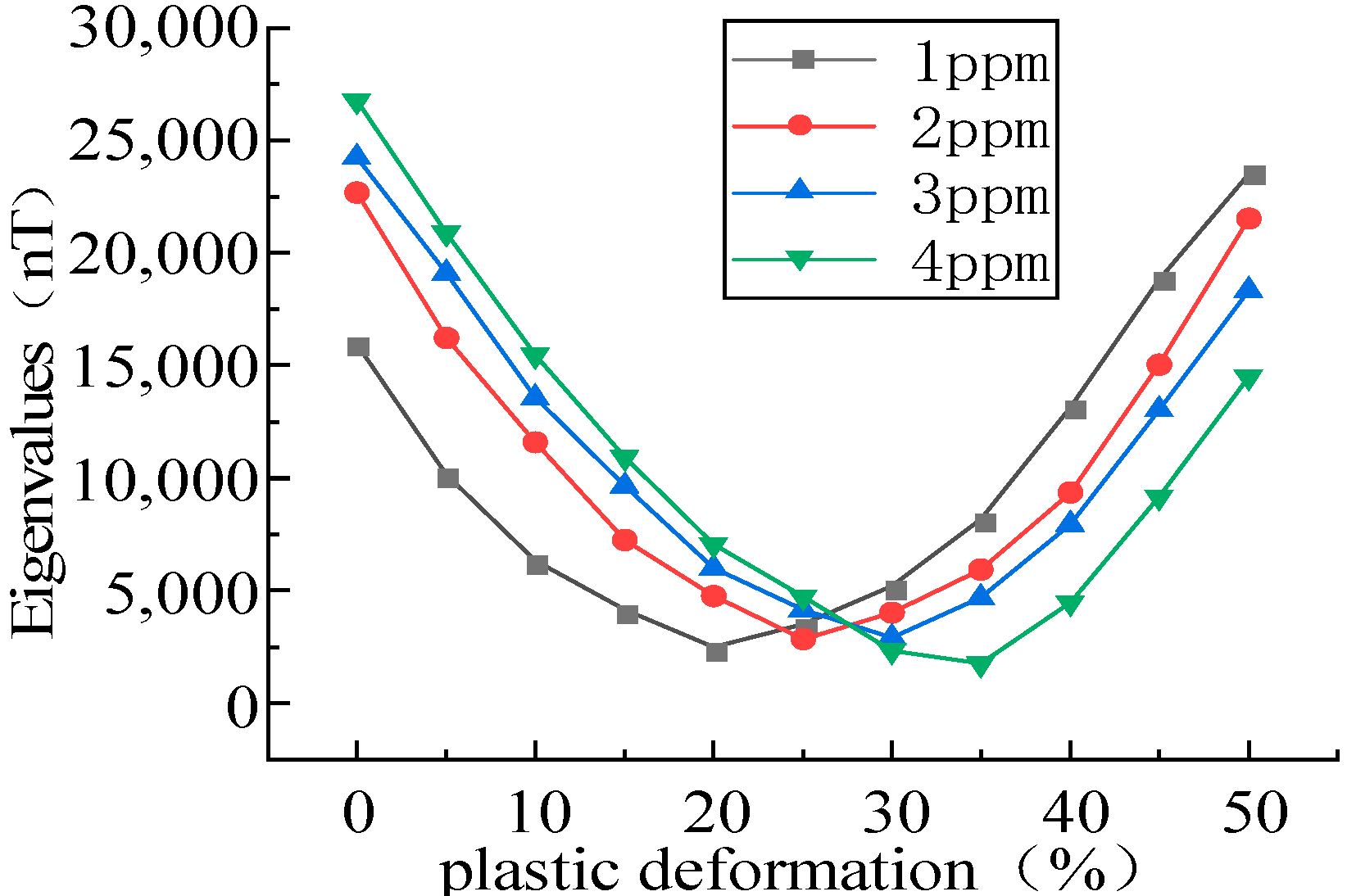
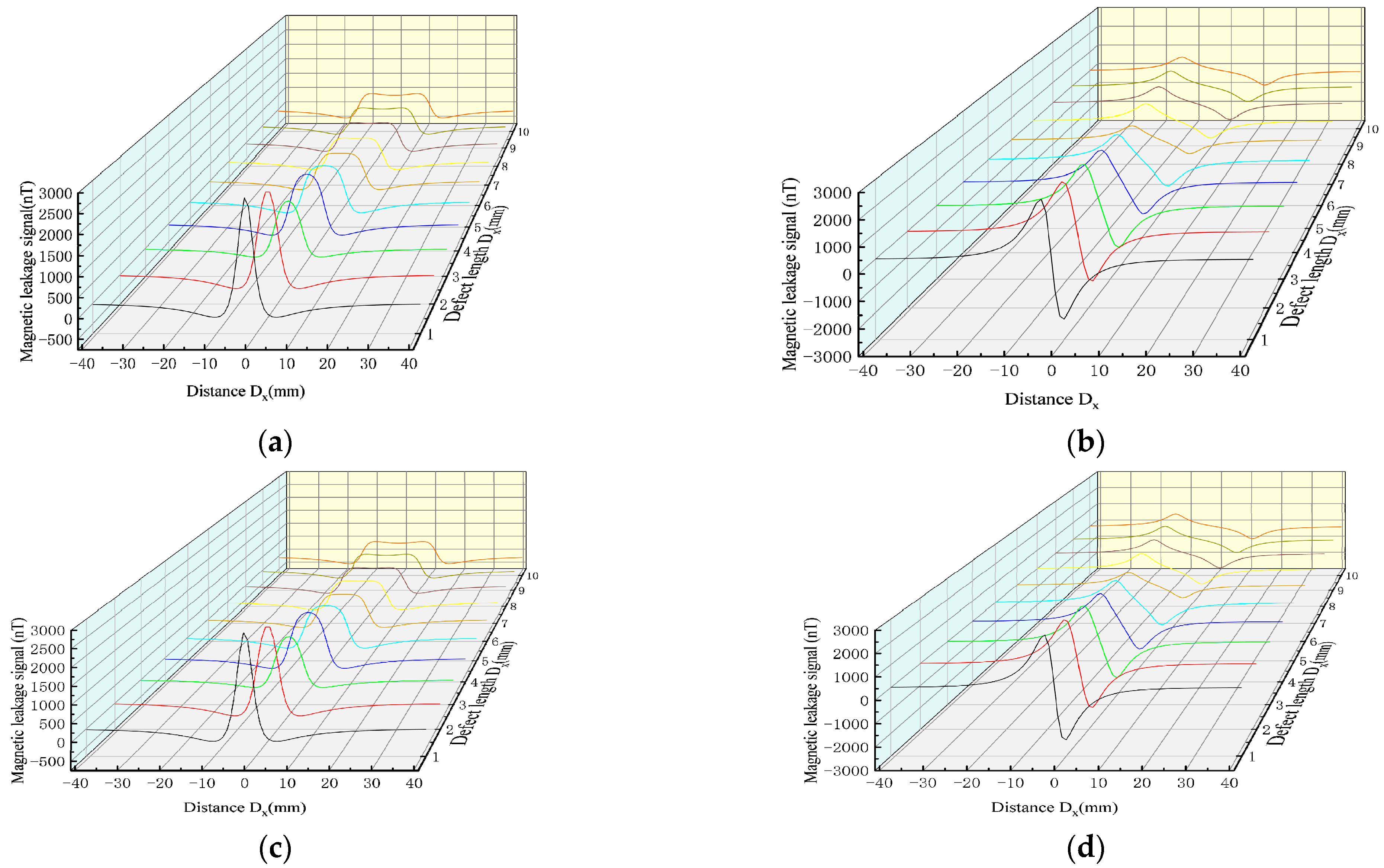


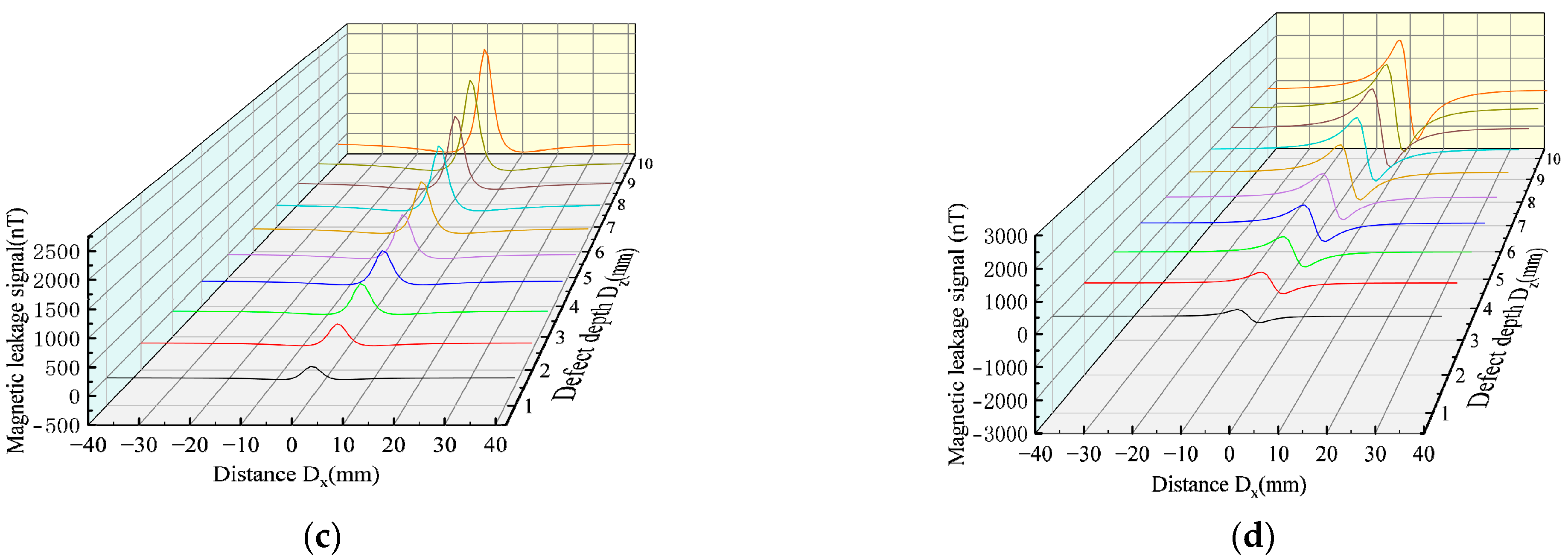


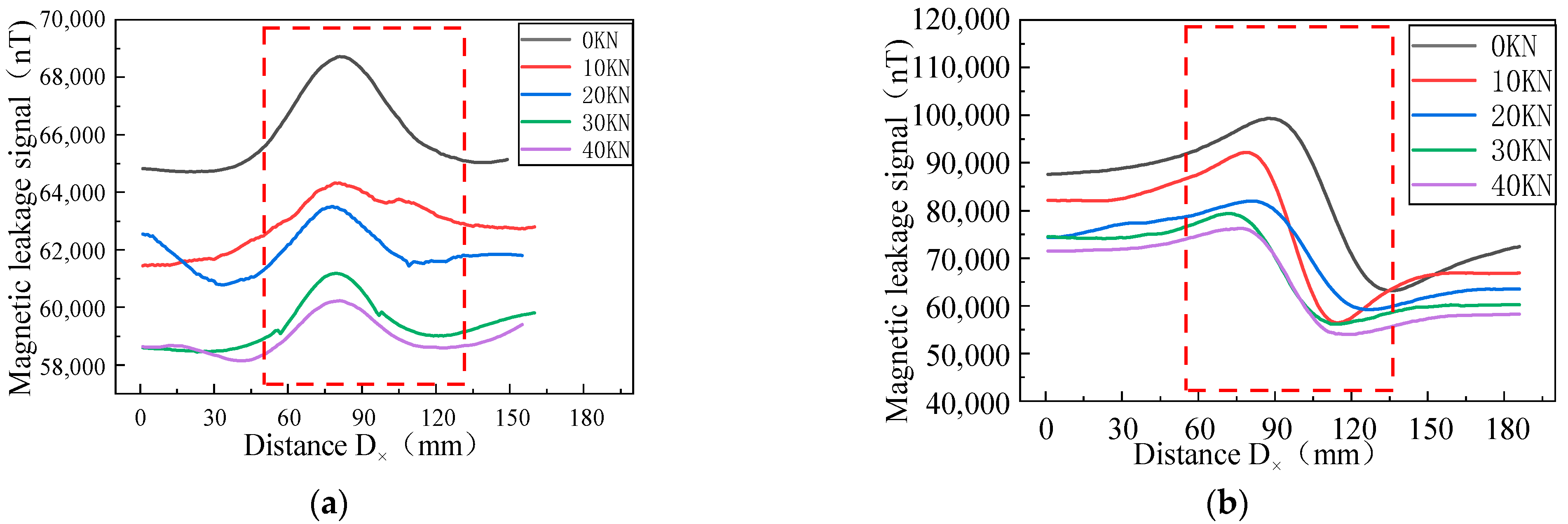
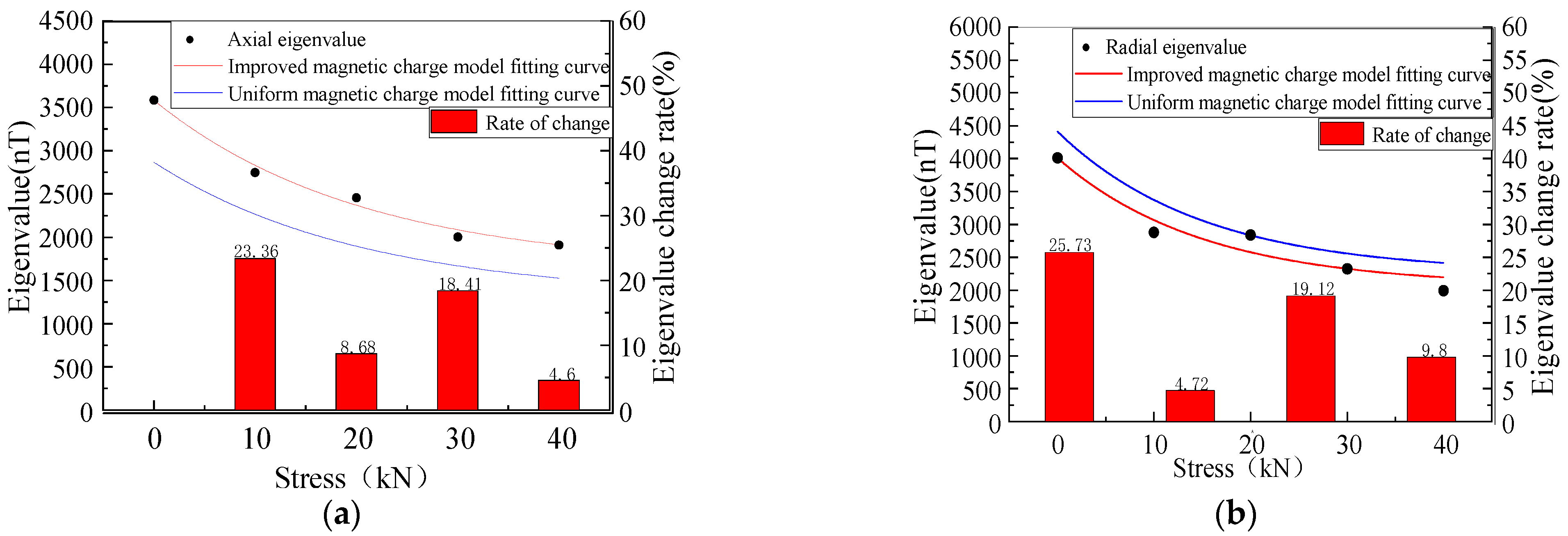
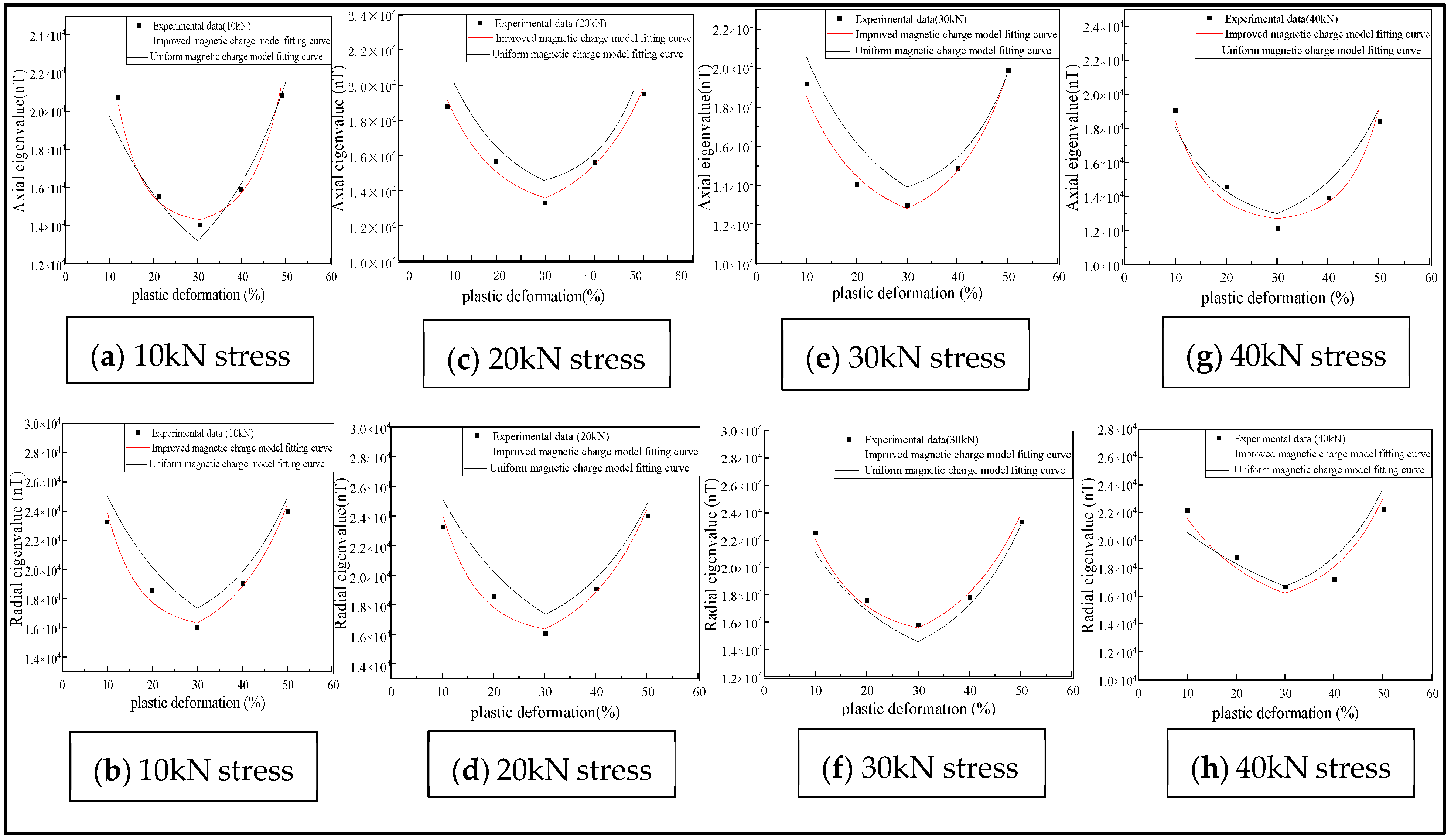
| Chemical Component (%) | Mechanical Property | |||||
|---|---|---|---|---|---|---|
| C | Si | Mn | P | S | Strength of Extension (Mpa) | Yield Strength (Mpa) |
| 0.12 | 0.45 | 1.07 | 0.025 | 0.015 | 570 | 485–638 |
| Accuracy of Improved Magnetic Charge Model (%) | Accuracy of Uniform Magnetic Charge Model (%) | |||
|---|---|---|---|---|
| Stress (kN) | Axial Component | Radial Component | Axial Component | Radial Component |
| 10 | 85.2 | 87.3 | 75.8 | 76.5 |
| 20 | 84.4 | 85.1 | 73.5 | 74.3 |
| 30 | 85.2 | 85.6 | 73.7 | 78.2 |
| 40 | 83.4 | 86.4 | 78.6 | 79.4 |
Disclaimer/Publisher’s Note: The statements, opinions and data contained in all publications are solely those of the individual author(s) and contributor(s) and not of MDPI and/or the editor(s). MDPI and/or the editor(s) disclaim responsibility for any injury to people or property resulting from any ideas, methods, instructions or products referred to in the content. |
© 2023 by the authors. Licensee MDPI, Basel, Switzerland. This article is an open access article distributed under the terms and conditions of the Creative Commons Attribution (CC BY) license (https://creativecommons.org/licenses/by/4.0/).
Share and Cite
Liu, B.; Ge, Q.; Wu, Z.; Lian, Z.; Yang, L.; Geng, H. The Signal Characteristics of Oil and Gas Pipeline Leakage Detection Based on Magneto-Mechanical Effects. Sensors 2023, 23, 1857. https://doi.org/10.3390/s23041857
Liu B, Ge Q, Wu Z, Lian Z, Yang L, Geng H. The Signal Characteristics of Oil and Gas Pipeline Leakage Detection Based on Magneto-Mechanical Effects. Sensors. 2023; 23(4):1857. https://doi.org/10.3390/s23041857
Chicago/Turabian StyleLiu, Bin, Qian Ge, Zihan Wu, Zheng Lian, Lijian Yang, and Hao Geng. 2023. "The Signal Characteristics of Oil and Gas Pipeline Leakage Detection Based on Magneto-Mechanical Effects" Sensors 23, no. 4: 1857. https://doi.org/10.3390/s23041857
APA StyleLiu, B., Ge, Q., Wu, Z., Lian, Z., Yang, L., & Geng, H. (2023). The Signal Characteristics of Oil and Gas Pipeline Leakage Detection Based on Magneto-Mechanical Effects. Sensors, 23(4), 1857. https://doi.org/10.3390/s23041857







